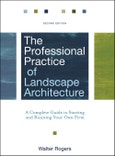The Professional Practice of Landscape Architecture, Second Edition is completely revised to keep up with the latest developments driving the day-to-day operation of a successful private-practice landscape architecture office. Whether helping a landscape architecture student identify a career track, providing direction on starting a new office, guiding an owner seeking to jumpstart a stagnant or fledgling business, or assisting a landscape architect-in-training study for the national Landscape Architecture Registration Exam (LARE), this single-source blueprint is the key to prospering in this dynamic field. This new edition features:
- Indispensible information for practicing landscape architects, including professional ethics, finances, office administration, marketing and promotion, and project management
- An updated look at government regulatory laws, federal tax administration, sustainable design, and LEED certification
- Strategies for using the Internet, computer software, and technology to market and manage a firm
- Examples of professional contract templates
- Case study profiles of landscape architecture firms
- Requirements for professional registration and criteria for taking the national exam
This comprehensive and practical reference combines real-world experience with the highest professional standards to instruct the reader on business concepts. Expertly organized and easy to follow, The Professional Practice of Landscape Architecture, Second Edition continues to be the one source that landscape architects need to direct all facets of their practice.
Table of Contents
Introduction.1 The Profession of Landscape Architecture and Professionalism.
Brief History of the Profession.
Professional Career Tracks.
Professional Licensure.
Professional Development.
Professional Societies.
The Influence of Technology on the Landscape Architecture Profession.
2 Clients and Projects.
Who Are the Landscape Architect’s Clients?
What Elements Determine the Landscape Architect’s Clients?
Landscape Architecture Projects.
Architectural and Engineering Clients.
Public-Sector Clients.
3 Case Studies.
HNTB Corporation: Large Multidisciplinary A/E Firm.
Large Landscape Architecture Firms.
The Acacia Group, Inc.: Small Landscape Architecture Firm.
ValleyCrest Landscape Development: Large Integrated.
Design-Build Firm.
Denver Service Center, National Park Service: Public Practice.
Rain Bird: Corporate Practice.
4 Professional-Practice Relationships.
Prime-Consulting Relationships.
Multiple Direct Consulting Relationships.
Subconsulting Relationships.
Landscape Architect/Owner Relationship.
Landscape Architect/Allied Professional Relationship.
Landscape Architect/Contractor Relationship.
Landscape Architect/General Public Relationship.
5 Finance.
Six Considerations for Raising Funds.
Three Phases of Financing a Firm.
Equity Financing.
Debt Financing.
How Lenders Evaluate a Loan Request.
Trade Credit.
Summary - Planning, Action, Adjustment.
6 Accounting.
The Landscape Architect as Financial Manager.
Financial Accounting Information.
Financial Management Information.
Financial Accounting Systems.
Recording Financial Information - Elementary Accounting.
Selecting an Accountant.
Accounting Software.
Overview of Accounting: Six Integrated Components.
7 Business Administration and Record Keeping.
Job Number - The Key to Office Administration.
Time Keeping.
Filing and Records Management.
Landscape Architecture Office Files and Records Management.
Vacations, Holidays, and Sick Leave or Paid Time Off.
Product Information Files, Technical Resources, and Code Information.
Payroll Administration.
Employer’s Tax Administration.
Tax Status of Nonwage Payments to Employees.
8 Marketing.
The Strategic Plan.
The Marketing Plan.
Marketing Tools and the Promotion Mix.
The Marketing Payoff.
Market Expansion - Entering New Markets.
The Marketing Staff.
9 Contracts.
Contract Basics.
Contracts with Clients - Professional Services Contract Formats.
The Elements of a Professional Services Contract with a Client.
Employment Agreements.
Negotiating a Contract.
Important Elements and Useful Contract Clauses.
10 Project Management.
What Is Project Management?
Planning, Scoping, and Organizing the Project.
Setting Up Tracking Systems.
Tracking a Project and Developing Strategies When a Project Is Over Budget or Off Schedule.
Selecting and Organizing Staff.
Directing and Motivating Project Staff.
Serving the Client and Developing a Friendly Relationship.
Providing Technical Supervision for the Project Staff.
Taking Part in Performance Reviews of Technical Staff.
Managing Construction Observation Services.
Summary.
11 Business and Personnel Law.
The Legal Environment of Professional Practice.
Discrimination.
Protecting the General Public, the Environment, and the Consumer.
Index.
Samples

LOADING...








